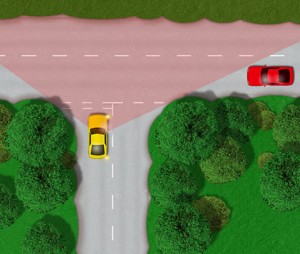Creep and peep is the term used for emerging from a closed or blind junction from a side road, moving forward slowly.
Junctions with Stop signs are typically closed or blind and will require the creep and peep driving technique. To perfect the creep and peep technique, a high level of clutch control is essential along with excellent observation. Driving tests are highly likely to involve closed junctions.
These types of junctions are implemented into the driving test routes so that the examiner can assess your ability to control the car, observational awareness and key decision making. This tutorial explains the creep and peep driving technique.
The diagram displays a closed T-junction where the yellow car is emerging from the side road into the main road. The red shaded area indicates the observable area that the driver of the yellow car can see into the road he intends on joining.
As can be seen from the image below, the driver of the yellow car cannot see a great deal as the approaching red car is out of sight and almost opposite the junction.

The driver of the yellow cars only option is to very slowly edge forward using the creep and peep technique. A driver will often no know if the creep and peep technique is required until they almost reach the junction lines. The only sure way to know is if the junction has a stop sign as this will tell a driver the junction is hazardous.
Always approach a junction using the MSPSL routine, driving cautiously, at an appropriate speed so that you can safely stop at the junction if necessary.
If the junction requires stopping, block gear change from whichever gear you are approaching the junction, straight into first around five metres from the junction line. If on a slope, you may need to apply the handbrake after you have stopped.
To use the creep and peep technique, very smoothly and gently raise and lower the clutch through the bite point. This clutch control technique will allow you to move forward extremely slowly. See clutch control and biting point for further information on this technique. Unless on a uphill slope, cover the brake in preparation to stop quickly.
As you are slowly moving forward, continuously and briskly look left and right up and down the road that you intend to merge into and be prepared to stop by quickly and firmly pressing the foot brake if a vehicle is approaching.
The danger associated with closed junctions such as this is that it puts you in a hazardous position, potentially in the path of oncoming vehicles that may need to swerve around you. You may find that courteous drivers will stop to allow you to proceed from the junction.
RELATED TUTORIALS where Creep and Peep May be Used
- The road junctions tutorial provides a guide on how to best approach junctions
- The types of junctions guides you on the various types of junction you may see
- The turning left at a junction tutorial provides the correct procedure for turning left
- The turning right at a junction tutorial provides the correct procedure for turning right
- The box junction tutorial explains what should and should not be done
- The Y Junctions tutorial explains their meaning and potential hazards
- This D Junctions tutorial covers this unusual junction type.
- The emerging from a junction / side road tutorial offers advice for emerging out of various types of challenging junctions
- Staggered junctions and how best to use them
- Junction lines and how to assess where to stop
- Junction signs – what to look out for

Very good hand out